|
Our
month-long tribute to Monsters and their
Movies continues
as this week's film topples out of the
blocks with Paul Frees
waxing a nice planetarium speech about
meteors. And according to him, while most
of these space rocks burn up upon entry
into the atmosphere, some of the tougher
ones make it through and create some
pretty big potholes on impact. Most are
harmless, he continues, and prove a
treasure for scientific study, but, as his
speech needles toward ominous, some might prove
deadly -- just as a huge flaming meteor
augers itself into the earth (--
that looks suspiciously like the spaceship
crash-landing from It
Came from Outer Space).
And as the smoke and dust settles over the
smoldering impact crater, the credits
roll.
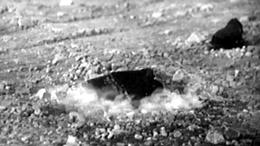
The
next day, we pan over the same desert and
spy an oncoming car. (And a
quick glance at the credits confirms weíre in Jack Arnold country.) Behind
the wheel, Ben Gilbert (Phil
Harvey), a geologist working for the state
of California, has to stop when the
radiator overheats. And while Gilbert refills it, we notice along with him that
the large amount of jet-black rocks
littering the valley floor don't look like they really
belong there. Curious, he
picks one of them up and moves on. (Your
tax dollars at work people.) As
he drives away, we zoom back to where he
slopped some water onto the ground and
see one of those oddball black rocks sitting
in the middle of the puddle have
a violent, phosphorous-like reaction to the
liquid. (That
canít be good.) Upon returning to
his office in San Angelo, Gilbertís
joined by Cochran (Les Tremayne),
the local newspaperman, who grumps over
how this quiet little town has no need for him
or his newspaper. To cheer him up, Gilbert
shows off the mysterious black rock but
Cochran doesnít think finding a rock in
the middle of the desert is really
earth-shattering news.
But
later that night, in one of those
disastrous chain of events (--
that always seems to trigger one of these
nature gone wrong films), a beaker
of water is accidentally spilled on the
black rock, and just like its brethren, it
reacts violently. When Gilbert discovers
this phenomenon, as he comes in for a
closer look, the music turns ominous and
we fade to black. (Nice knowing you,
Ben.) The
next day, when Gilbertís
partner, Dave Miller (Grant
Williams), returns to the office,
he finds it all a shamble and more of
those black
rocks scattered everywhere. Calling out to his friend,
Miller spots Gilbert
standing in the hall -- but strangely, he
doesnít answer. When Miller
approaches, he discovers that Gilbert is
dead; petrified -- seemingly turned to
solid stone!
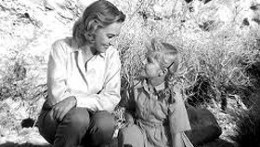
Meanwhile,
out on the desert, Kathy Barret (Lola
Albright) finishes her field trip
by turning her rabid grade school class
loose to look for souvenirs. ("Look!
I found a gila monster. Oww!" Ritalin
obviously hadnít been invented yet.)
And after young Ginny Simpson (Linda
Scheley) finds one of the deadly
black rocks for her souvenir, the little
girl asks
Kathy if she and Dave are ever going to
get married like the lizards theyíre
watching. (Yes, itís as funny as
it sounds.) This
plot-specific field trip also establishes
the existence of a salt mine and a large
irrigation dam located close to San
Angelo. (I
wonder if thatís pertinent? Nah...) With
all of that out of the way, and the field
trip concluded, Kathy drops Ginny
off at her home, where Ginny's mom wonít
let her bring the dirty old rock inside
unless she washes it first. (Uh-oh.)
And as Ginny turns on the spigot, her mom calls her in for dinner, causing
the girl to abandon the rock in a washtub
filled to the brim with water, triggering
another round of the same ominous music as the water
starts to boil and bubble...
Later,
Kathy joins Miller,
Cochran and Sheriff Corey (William
Flaherty) to hear the report on
Gilbertís autopsy. Alas, the local
doctor is stumped and plans to send the
body on to Los Angeles and have a
specialist look at it. When Cochran asks
what he can print, Corey advises him to
sit on the story to prevent a panic until
they can piece together what happened.
Since Cochran was the last person to see
Gilbert alive, he mentions the strange
black rock the dead man found. Miller
is puzzled by this use of a singular, because there was definitely
more than one rock in the
demolished lab; and when he describes it,
Kathy is frightened because it sounds
exactly like the same kind of weird rock Ginny
found ... Heading out to the Simpson farm,
Corey, Miller and Kathy find it completely
demolished and covered with the same black
rocks -- only they're a lot bigger this
time. Suddenly, they hear something moving
amongst the wreckage. Turns out it's
Ginny, barely alive and succumbing to
shock -- and like Gilbert, it appears her
extremities have turned to stone. Digging
further, they also find the completely
petrified bodies of her parents.
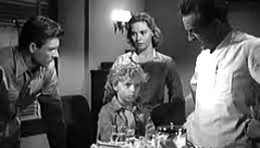
Rushing
Ginny to Los Angeles for the best medical
care, but, it turns out theyíre experts
are just as stumped as the San Angelo
doctor. All they can do is put Ginny in an
iron lung to stabilize her while they run
more tests. Meanwhile,
Miller
runs his own tests on the mystery rocks,
but finds they're nothing more than an
ordinary amalgam of silicates. (It
does have a negative cleavage though. I
wonder what that means?) Stumped, he
turns to his old college professor, Arthur
Flanders (Trevor Bardette),
who agrees with his analysis; it
appears to be an ordinary rock, but due to
itís mysterious duplicative properties,
he conjectures further, which means maybe
itís not from the Earth at all. (He
typed ominously...)
While
Kathy stays at the hospital with Ginny,
who only has an estimated 8-hours to live
before she completely succumbs to the
petrification, Miller and Flanders
hightail it back to San Angelo to look for
more clues on how to fight this progressive
malady. Heading to the Simpson ranch
first, Flanders notices the immediate
soil around the black rocks is a different
color. After a quick analysis, they
conclude all the silica has been
removed from the sand. Assuming, then,
that the rocks are somehow absorbing all
the silica, this has to be what killed all
the people; since silicon is what gives
our moving parts and skin their
elasticity;
and if all the silicon were removed, the
body would turn rock solid. (Okay,
having flunked anatomy, Iíll buy that.)
When
they pass this theory on to Ginnyís
doctor, he gives her a silicon booster
shot and waits to see if it has any
effect.
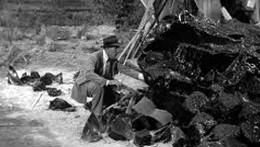
Meanwhile,
Miller and Flanders keep poking around and
eventually find the original meteor and
take a sample of it back to the lab for
analysis. Something had to trigger the
deadly reaction, since just handling it
doesnít cause the same effect, so they
try heat and electricity and several
chemicals but nothing works. Outside, it
starts to thunder, and soon, itís
raining cats and dogs. (Better
catch up quick fellas, or youíre going
to be up to your nether regions in black
rocks PDQ.) Then
the much needed eureka moment comes when
Miller accidentally spills some coffee on
a sample. And as they apply more water
onto it, the rock grows, expanding
upwards, into a mini-crystalline obelisk
that soon collapses under its own weight
and shatters ... With that, all the pieces of the puzzle
quickly fall into place, but the happy
moment is brief when they realize how hard
itís raining: if
a small dose of water made the rock grow
to over three feet high, what
will all the rocks out in the desert do
under this deluge?
Jumping
into the car, they head back to the impact
crater to see how bad it is. Still several
miles away, Miller hits the brakes as a
gargantuan, black monolith rises into view,
and keeps on rising until it eventually
collapses and shatters, and then all the
broken pieces immediately start to grow
again. And as this process keeps
repeating, Miller dreadfully points out
that the monoliths will follow the natural
slope of the valley -- right into San
Angelo!
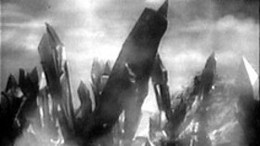
Rounding
up the Sheriff, it doesn't take long to
convince him of the exponentially growing
danger. And as he makes plans to evacuate
the town, they do receive some good news:
Millerís theory proved correct and Ginny
is expected to make a full recovery. And
with that confirmed, Miller decides to use a little
reverse-engineering and thinks maybe
something in Ginnyís booster-shot might
short-circuit the monolith's growth cycle.
He
gets the formula -- a little bit of this,
and little bit of that, suspended in
normal saline solution. (Salt
water? Wait a second. Irrigation dam? Salt
mine? Nah...) Meanwhile,
the rain has stopped but the monoliths
continue their destructive advance down
the valley, wiping out everything in their
path. (Thanks
to all the rain, the ground is saturated,
and thatís enough to keep the ball
rolling.) Knocking
out both the phone and power lines,
Corey turns to Cochran and his legion of
newsies to spread the word of the
emergency evacuation. But it may already
be too late for some as several, desperate
people rush into town, barely escaping the
onslaught, who are slowly succumbing to
the loss of silicon. Thankfully, Kathy
returns with several medics from LA to
help out these victims. She also finds
Miller and Flanders in the lab trying
every combination of chemicals off the
list, but nothing works until Miller
realizes they havenít tried the saline
solution yet. And when he dumps some
sodium on the rock, it stops the reaction
dead in its tracks!
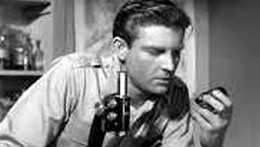
With
that, Miller thinks they can stop the
monoliths with a simple salt barrier, but
Flanders points out they donít have
enough time. Consulting a map, Millerís
wheels keep on spinning until he comes up
with a plan: blow up the dam and flood the
salt mine, creating a river of salt water
between the rocks and the town. (Itís
so crazy blah blah blah.) But
they canít blow up the dam without
permission from the governor, and while
waiting for the word, the explosives are
set, the town is evacuated, and the
monoliths come crashing into view. And if
they donít stop them there, at the
bottle-necked end of the valley, then there are no more
natural barriers and the monoliths will *gasp*
take over flatten the entire world!
And so, while the falling and
regenerating spires advance ever closer,
word comes that the governor is en route
to personally assess the situation and
take in the damage. But Flanders says if
they wait for him it will be too late, so
Miller gives the order to blow the dam.
It
goes off with a bang, and as the cascading
water sweeps over the salt mine and
torrents down the old riverbed between the
monoliths and the town, Miller asks
Flanders if there will be enough salt to
do the job. The professor quickly
calculates it out, crosses his fingers,
and replies it'll be real close. (So
we'll all cross our fingers.) And
as the lead spires tumble into the water,
the rest follow suit and all quickly
fizzle out. *whew*
The
world is saved. Well -- at least until it
starts raining again.
Cue
ominous music and fade to...
The
End
Make
no mistake about it, as a film production
entity, Universal International was in
deep trouble by 1950. All the studios lost
their theater chains as part of an
anti-trust settlement, audiences were
staying home to watch TV, and as their
theaters closed down, the company teetered
toward bankruptcy.
Enter
two men who would be credited with saving
the company. One was Arthur Lupin and his Francis
the Talking Mule pictures. (No,
Iím not kidding.) The
second was Jack Arnold, who, along with
producer William Alland, was instrumental
in generating Universalís second wave of
monster movies in the 1950's. Back in the '30s it
was the gothic horrors of The Wolfman,
Frankenstein and Dracula.
But the '50s was the atomic age, so most
horrors were caused by science gone awry,
alien invaders, or atomic mutations
running amok. A strange combination of all
the above, The
Monolith Monsters
is a novel film filled with novel ideas,
and itís amazing how you can take the
idea of falling rocks and make it
interesting -- let alone menacing and
entertaining. Again, The
Monolith Monsters
manages all of the above.
These
dreaded monoliths are the fulcrum but the
mystery of their deadly life-cycle is the
lever that moves the plot along. Some of
the best sci-fi movies, like
THEM!,
don't show their hand too early, and that
it takes a while for our heroes to unravel
this mystery is what really endears this
movie to me. Also, some thought process went
into the science behind it, too; and to me, of
all the monster movies I've seen, this one
seems the most plausible. Itís not based
entirely in scientific fact but it
doesnít take a quantum leap in the
suspension of disbelief to buy it. Usually,
my suspension of disbelief is overtaxed
and broken down by the end of these films.
But not this time. Arnold
had a hand in the story, here, but John
Sherwood did the directing. On the
surface, its plot is
the same as any other sci-fi movie of its
strata, but
there are some subtle differences: the
hero doesnít know everything and turns
to someone with greater knowledge when he
needs it. Williams does make a likeable
hero, but Albright is remarkably absent as
the heroine. And the film manages a real
sense of urgency because the normal route
of calling in the army and bombing the
hell out of the monoliths is out of the
question. These things can't be reasoned
with, and are truly unstoppable, making
them one of the greatest sci-fi menaces to
ever menace.
Unfortunately,
The
Monolith Monsters
was one of the last serious sci-fi films
of this type produced by Universal
International as its focus shifted to even
cheaper and more
juvenile sci-fi, with things like Monster
on the Campus,
and spent most of its time distributing
other, smaller companies sci-fi films instead of
making their own. Following suit, Jack
Arnold eventually moved on to TV and
directed episodes of Rawhide
and Gilliganís
Island.
And he stayed in the medium and eventually
directed episodes of The
Love Boat
and The
Fall Guy.
And I recall reading, somewhere, that John
Carpenter had the option of remaking
either The
Thing
or The
Creature from the Black Lagoon
back in 1983. And I also remember reading that if he had
chose the ladder, he wanted to get Arnold
involved in the production somehow. Am I
crazy? Am I the only one who remembers
this?
|